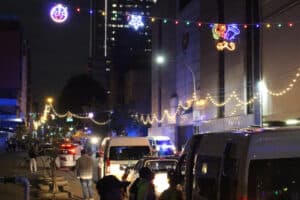Load shedding left a trail of destruction with appliances, substations and transformers exploding, costing the country even more billions.

The five-day rotational load shedding, halted yesterday, did not only turn lives upside down and cost the country billions, but also left a trail of destruction, with mini-substations and transformers popping and exploding in Johannesburg.
Hundreds of consumers also lost appliances to voltage surges when the power came on after shedding.
Cable thieves wasted no time in taking advantage of the situation, digging up electricity cables to sell as scrap, which compounded the effects of damaged substations and transformers and left parts of the city without power long after load shedding was suspended yesterday.
City Power yesterday said the damage to the infrastructure was due to “inrush current” during restoration of power after load shedding.
City Power attended to at least 400 calls from customers in the morning alone, with 159 of them coming from Hurst Hill depot, covering Auckland Park, Rosebank, Northcliff, and Cresta; and Reuven depot area, which covers Glenvista, Southgate, Kiblerpark, Naturena, Mondeor, and Winchester.
The metro was also inundated with calls from residents reporting damaged appliances due to insurge of current on restoration.
Isaac Mangena, City Power spokesperson, said they always encouraged residents to switch off appliances during load shedding to avoid damage due to insurge of current during restoration.
“Often when electricity goes you find people were using appliances and forget to switch them off, leaving stuff on stoves or irons exposed and they catch fire when electricity returns in their absence,” he said.
Mangena said they had their resources stretched throughout the past five days, saying technicians had to attend to explosions, cables faults and theft.
“We don’t have the cost (implications) currently because it’s still early but it should be going into millions [of rands],” he said.
City Power CEO Lerato Setshedi said their system took a serious knock during load shedding, saying most of their equipment, including switchgear and cables, was old and failed.
“The effects of load shedding accelerate the ageing of the infrastructure,” she said.
City Power anticipates that it will take up to three days to clear all the outstanding calls and get the system back on track.
Andrew Etzinger, Eskom’s senior general manager for demand management, said it has been a “horrid” week, but said there has been consistent progress in getting the generators back into service, as well as diesel to drive open-cycle gas turbine plants.
Speaking to Kieno Kammies on Cape Talk radio, he said the situation was also aided by a lower peak on Fridays, as businesses close for the weekend.
Explaining what went wrong, Etzinger said Eskom has 15 coal-burning power stations predominantly in the north-east and Mpumalanga, with six generators or units each.
“Seven of those power stations’ units went off for a variety of reasons that took us from stage two to stage four,” he said.
Etzinger said they had run out of diesel because they have been burning R100 million worth of diesel per day, bringing the cost to billions rands.
For more news your way, download The Citizen’s app for iOS and Android.






